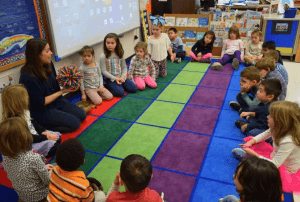Becoming a mindfulness instructor required me to let go of my assumptions about how students need to learn and teachers need to teach. I have learned that my role in teaching mindfulness is to create an open, welcoming space. Then students can explore their inner life and learn tools that empower them to choose how they want to respond to the world around them.
Before I taught my first mindfulness class, I was nervous. My mind was busy running through my lesson plan, preparing for all of the possible ways the lesson could go wrong. I soon discovered, however, that my job was not to deliver the perfect mindfulness lesson, but to let the lessons unfold as the students explore themselves and their experience, to allow the students to be their own curriculum.
Letting the Lesson Unfold
In many ways, mindfulness requires certain radical shifts, away from directing students to be a certain way, and instead inviting them to notice what it is like to be a certain way. We take a break from the messaging that students hear all too often that they are “doing it wrong” or that there is something wrong with them. As mindfulness teachers, we are not trying to change student behavior. Instead, we are empowering students with life-long skills to better understand themselves and their behavior.
The magic of teaching mindfulness is that anything that happens in the classroom can be the subject of a wonderful mindfulness lesson. In fact, the students themselves provide the content of each lesson. As a teacher, this requires a letting go of any concept of how the students should respond to each lesson, or even what they should learn. Instead, I have to remain open and curious and simply embrace their experiences as the true lessons.
For example, if students find a one-minute mindful breathing exercise calming and relaxing, I ask them to notice how that feels and point out how they can use that tool when they want to calm down. For students who cannot sit still or are restless and distracted during the breathing exercise, I ask them to notice that they are distracted, to pay attention to how their bodies feel as they are moving, or to recognize how challenging this can be and how to sit with that discomfort. All of their experiences are valid and useful as a way of developing insight, acceptance and self-awareness.
You Can’t Do This Wrong
Learning to notice and explore our experience and how we respond to the world around us is exactly the point of mindfulness practice. This self-awareness helps students discover how to find moments of calm, connect to their inner strength, observe when they are distracted, focus their attention when they need to, sit with feelings of discomfort, and cultivate compassion and kindness for themselves and for others. They are developing what I call their Mindfulness Super Powers of self-awareness, compassion, resilience, self-regulation and inner wisdom. And, most importantly, they are learning that their way of being is not bad or good, right or wrong, it is just what they are experiencing right now and that’s perfect.
Cheryl Vigder Brause is a mindfulness educator and a graduate of the Mindful Schools Mindful Teacher Certification Program. She is the founder and director of 2bpresent, an organization that provides classes, workshops and private sessions to adults, teens and children on mindfulness, and recently produced a set of guided meditations for teens.

